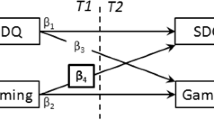Abstract
This paper explores the use of body and movement studies in the preschool curriculum to address socio-emotional development. Findings in affect psychology, neuroscience, and dance/movement therapy provide evidence for the importance of an integrated emotional processing system. Given space and time to experiment with expressive movement in the preschool classroom, young children explore their somatic and emotional experiences. Their ability to recognize, regulate, and express emotion echoes their developing use of movement as an alternative mode of representation. Through movement study, children become better able to connect their visceral emotional processing to conscious appraisal. It is this integrated system of body and emotion that contributes to a strong sense of the self as an emotional, social, and cognitive being.
Similar content being viewed by others
Notes
All names have been changed.
References
Adolphs, R. (2006). The social brain. Engineering and Science, 69(1), 2–8.
Bechara, A., Damasio, H., Tranel, D., & Damasio, A. R. (2005). The Iowa gambling task and the somatic marker hypothesis: Some questions and answers. Trends in Cognitive Sciences, 9(4), 159–162.
Benjamin, J. (1988). The bonds of love: Psychoanalysis, feminism, and the problem of domination. New York: Pantheon Books.
Berk, L. E., & Winsler, A. (1995). Scaffolding children’s learning: Vygotsky and early childhood education. Washington: National Association for the Education of Young Children.
Boone, R. T., & Cunningham, J. G. (1998). Children’s decoding of emotion in expressive body movement: The development of cue attunement. Developmental Psychology, 34(5), 1007–1016.
Clore, G. L., & Huntsinger, J. R. (2007). How emotions inform judgment and regulate thought. Trends in Cognitive Sciences, 11(9), 393–399.
Cook, S. W., Mitchell, Z., & Goldin-Meadow, S. (2008). Gesturing makes learning last. Cognition, 106(2), 1047–1058.
Damasio, A. R. (1994). Descartes’ error: Emotion, reason, and the human brain. New York: G.P. Putnam.
Dolan, R. J. (2002). Emotion, cognition and behavior. Science, 298, 1191–1194.
Fox, N. A., & Campos, J. J. (1994). The development of emotion regulation: Biological and behavioral considerations. Chicago: University of Chicago Press.
Franklin, M. B., & Biber, B. (1974). Psychological perspectives and early childhood education: Some relations between theory and practice. Urbana, IL: ERIC Clearing House on Early Childhood Education.
Freedberg, D., & Gallese, V. (2007). Motion, emotion and empathy in esthetic experience. Trends in Cognitive Sciences, 11(5), 197–203.
Frith, C. D., & Frith, U. (2006). How we predict what other people are going to do. Brain Research, 1079(1), 36–46.
Frith, C. D., & Frith, U. (2007). Social cognition in humans. Current Biology, 17(16), R724–R732.
Gilbert, A. G., & National Dance Association. (1992). Creative dance for all ages: A conceptual approach. Reston, VA: AAHPERD.
Hayden, B., & Platt, M. (2006). Fool me once, shame on me—fool me twice, blame the ACC. Nature Neuroscience, 9, 857–859.
Hervey, L. W. (2000). Artistic inquiry in dance/movement therapy: Creative research alternatives. Springfield, IL: Charles C Thomas.
James, W. (1884). What is an Emotion? Mind, 9, 188–205.
Johnson, M. H. (2003). Development of human brain functions. Biological Psychiatry, 54(12), 1312–1316.
Joyce, M. (1994). First steps in teaching creative dance to children. MountainView, CA: Mayfield Pub. Co.
LeDoux, J. E. (1996). The emotional brain: The mysterious underpinnings of emotional life. New York: Simon & Schuster.
Levy, F. J. (1995). Dance and other expressive art therapies: When words are not enough. New York: Routledge.
Levy, F. J. (2005). Dancemovement therapy: A healing art (Rev. ed. ed.). Reston, VA: AAHPERD.
Lewis, M. (2000). The emergence of human emotions. In M. Lewis & J. M. Haviland-Jones (Eds.), Handbook of emotions (2nd ed., pp. 265–280). New York: Guilford Press.
Lupyan, G. (2006). Labels facilitate learning of novel categories. In A. Cangelosi, A. D. M. Smith, & K. R. Smith (Eds.), The evolution of language: Proceedings of the 6th International Conference (pp. 190–197). Singapore: World Scientific.
Piaget, J. (1969). The psychology of the child. New York: Basic Books.
Stern, D. (1985). The interpersonal world of the infant. New York: Basic Books.
Winnicott, D. W. (1989). Playing and reality. London: Routledge.
Winters, A. F. (2008). Emotion, embodiment, and mirror neurons in dance/movement therapy: A connection across disciplines. American Journal of Dance Therapy, 30(2), 84–105.
Author information
Authors and Affiliations
Corresponding author
Rights and permissions
About this article
Cite this article
Thom, L. From Simple Line to Expressive Movement: The Use of Creative Movement to Enhance Socio-Emotional Development in the Preschool Curriculum. Am J Dance Ther 32, 100–112 (2010). https://doi.org/10.1007/s10465-010-9090-2
Published:
Issue Date:
DOI: https://doi.org/10.1007/s10465-010-9090-2




